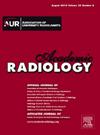Early Lung Adenocarcinoma Manifesting as Irregular Subsolid Nodules: Clinical and CT Characteristics
IF 3.8
2区 医学
Q1 RADIOLOGY, NUCLEAR MEDICINE & MEDICAL IMAGING
引用次数: 0
Abstract
Rationale and Objectives
To explore the clinical and computed tomography (CT) characteristics of early-stage lung adenocarcinoma (LADC) that presents with an irregular shape.
Materials and Methods
The CT data of 575 patients with stage IA LADC and 295 with persistent inflammatory lesion (PIL) manifesting as subsolid nodules (SSNs) were analyzed retrospectively. Among these patients, we selected 233 patients with LADC and 140 patients with PIL, who showed irregular SSNs, hereinafter referred to as irregular LADC (I-LADC) and irregular PIL (I-PIL), respectively. The incidence rates, clinical characteristics, and CT features of I-LADC and I-PIL were compared. Additionally, binary logistic regression analysis was performed to determine the independent factors for diagnosing I-LADC.
Results
The incidence rates of I-LADC and I-PIL were 40.5% (233/575) and 47.5% (140/295), respectively, with no statistically significant difference observed between the two groups (P > 0.05). Univariate analysis revealed significant differences in three clinical characteristics and 13 radiological features between I-LADC and I-PIL (all P < 0.05). Binary logistic regression indicated that the alignment of the long axis of SSN with the bronchial vascular bundle, a well-defined boundary of ground-glass opacity, lobulation, arc concave sign, and absence of knife-like change were the independent predictors of I-LADC, yielding an area under the curve and accuracy of 0.979% and 93.5%, respectively.
Conclusion
Early LADC presenting as SSNs is associated with a high incidence of irregular shape. I-LADC and I-PIL exhibited different clinical and imaging characteristics. A good understanding of these differences may be helpful for the accurate diagnosis of I-LADC.
表现为不规则实下结节的早期肺腺癌的临床和CT特征。
目的:探讨不规则形状的早期肺腺癌(LADC)的临床和CT特征。材料与方法:回顾性分析575例IA期LADC和295例以亚实性结节(ssn)为表现的持续性炎性病变(PIL)的CT资料。在这些患者中,我们选择了233例LADC患者和140例PIL患者,他们分别表现为不规则的ssn,以下分别称为不规则LADC (I-LADC)和不规则PIL (I-PIL)。比较I-LADC和I-PIL的发病率、临床特点及CT表现。此外,进行二元logistic回归分析以确定诊断I-LADC的独立因素。结果:I-LADC和I-PIL的发病率分别为40.5%(233/575)和47.5%(140/295),两组间差异无统计学意义(P < 0.05)。单因素分析显示,I-LADC和I-PIL在3项临床特征和13项影像学特征上差异均有统计学意义(P < 0.05)。二元logistic回归结果显示,SSN长轴与支气管维管束的排列、磨玻璃样混浊边界清晰、分叶化、弧形凹征、无刀样改变是I-LADC的独立预测因子,曲线下面积和准确率分别为0.979%和93.5%。结论:早期LADC表现为ssn,不规则形状发生率高。I-LADC和I-PIL表现出不同的临床和影像学特征。了解这些差异可能有助于I-LADC的准确诊断。
本文章由计算机程序翻译,如有差异,请以英文原文为准。
求助全文
约1分钟内获得全文
求助全文
来源期刊

Academic Radiology
医学-核医学
CiteScore
7.60
自引率
10.40%
发文量
432
审稿时长
18 days
期刊介绍:
Academic Radiology publishes original reports of clinical and laboratory investigations in diagnostic imaging, the diagnostic use of radioactive isotopes, computed tomography, positron emission tomography, magnetic resonance imaging, ultrasound, digital subtraction angiography, image-guided interventions and related techniques. It also includes brief technical reports describing original observations, techniques, and instrumental developments; state-of-the-art reports on clinical issues, new technology and other topics of current medical importance; meta-analyses; scientific studies and opinions on radiologic education; and letters to the Editor.
 求助内容:
求助内容: 应助结果提醒方式:
应助结果提醒方式:


